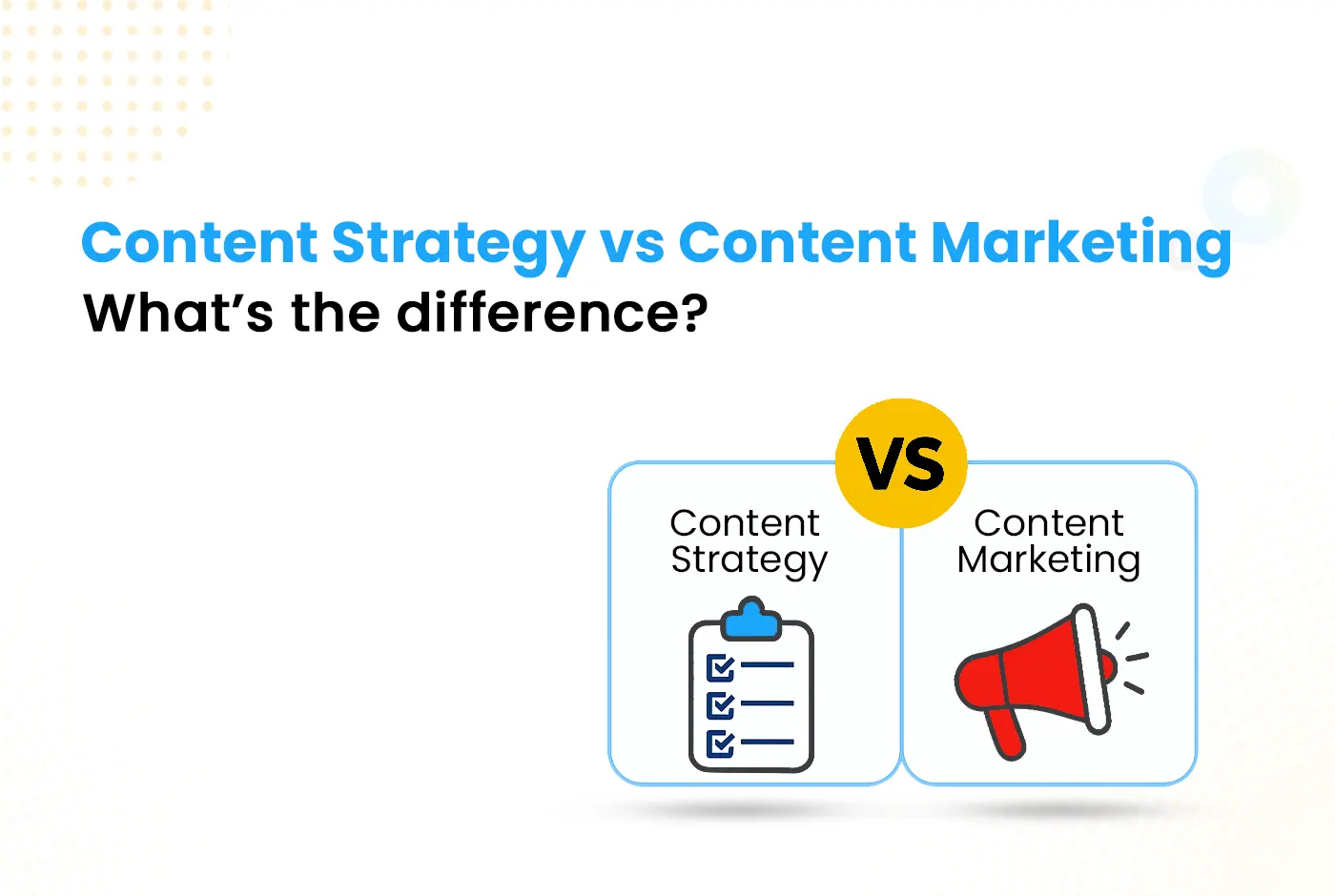Content Strategy vs Content Marketing: What’s the Difference?

Listen to this article
Table of Contents
The phrase ‘Content is king’ is often repeated in digital marketing. This is why it’s crucial to create content with coherence, purpose and alignment to deliver sustained impact. The key to do that is understanding the distinction between content strategy vs content marketing becomes vital. Many confuse the two, or use them interchangeably but they serve distinct functions in a content-led growth engine.
A robust content strategy shapes why, what, who, and how you publish content, while content marketing is how you bring that strategy to life- through creation, distribution, promotion, and optimization. Getting both right ensures your content doesn’t just exist, it works. Let’s dig in to see exactly how differently these two function.
What Is Content Strategy?
Content strategy is the planning, governance, and management of content as a strategic asset. In other words, it’s not just “making content,” but defining why you create it, for whom, where, and how you maintain it over time. It’s about aligning content with business goals, brand voice, user needs, structure, distribution, and lifecycle management.
Key elements of content strategy include:
- Audience & personas: Who are you writing for? What problems, needs, preferences, and journeys do they have?
- Content goals & KPIs: Do you prioritize awareness, lead generation, retention, or thought leadership?
- Content audit & gap analysis: What content do you already have? What’s working, what’s outdated, what’s missing?
- Content model & structure: How will you organize content types, templates, taxonomy, metadata?
- Voice, tone, and style guide: Consistency across all content touchpoints is critical.
- Governance & workflow: Who creates, edits, publishes, reviews, and updates content on what timeline?
- Distribution & promotion framework: Which channels? Which formats? What repurposing strategy?
- Maintenance & lifecycle planning: When to refresh, archive, or retire content.
In short, content strategy makes content a cohesive, sustainable, goal‑driven function, not bits and pieces.
What Is Content Marketing?
Content marketing is the execution side: creating, publishing, and promoting content to attract, engage, and convert your target audience. It’s tactical, measurable, more immediate.
According to industry definitions, “Content marketing is a marketing technique of creating and distributing valuable, relevant content to attract, acquire, and engage a clearly defined audience with the objective of driving profitable customer action.”
In practice,trends in content marketing includes:
- Blogging, articles, guides, eBooks
- Case studies, whitepapers, reports
- Videos, podcasts, webinars
- Infographics, visuals, interactive content
- Email newsletters, social media posts, drip campaigns
- Promotional content (offers, landing pages, lead magnets)
- Guest posts, syndication, content partnerships
Where content strategy is the blueprint, content marketing is the engine that powers traffic, leads, and conversions.
Difference between the two: Content Strategy vs Content Marketing
- Core focus: Content strategy includes governance, structure and planning of the content, while content marketing includes execution, promotion and measurement.
- Time horizon: The time horizon is long-term and sustainable in content strategy and campaign-oriented in content marketing.
- Role: Content strategy includes planning and organizational alignment while content marketing is tactical and includes distribution.
- Questions addressed for who, what, why, where, when, and how for content strategy, and answers to what content when to publish and how to promote come in Content Marketing.
- Metrics: Content health, content ROI, content gap closure are aspects of Content Strategy. Views, engagement leads, conversions are all part of Content Marketing.
- Example deliverables: For content strategy- Editorial brief, content plan, style guide, governance docs. For Content Marketing- Blog posts, videos, social posts, email series.
As one metaphor puts it, ‘Strategy is the recipe, Marketing is the cooking’, meaning that the content strategists think holistically across the entire content process, while content marketers operate within that structure to deliver results.
Why They Must Work Together
The power is in their synergy. Without strategy, content marketing risks being aimless or inconsistent. Without marketing, strategy is just a document; it never moves the needle.
Here’s how they reinforce each other:
- Strategy guides priorities: It helps you choose which topics, formats, and channels to invest in, rather than spreading thin.
- Marketing tests & validates: Tactical execution surfaces what resonates, which feedback loops into improving your strategy.
- Sustainable content growth: Strategy ensures you don’t just produce content for the moment, but build a content asset base that compounds.
- Governance & consistency: A strategy ensures brand, voice, and quality don’t degrade over time, even as marketing scales.
- Resource efficiency: You avoid duplication, content gaps, and wasted effort when strategy and marketing are aligned.
At the end of the day, content strategy builds the foundation and content marketing builds the building.
Final Thoughts
Trends & Future in 2026 include generative AI & content assistants, Answer Engine Optimization (AEO), Content as product and education, and Governance for multiple channels & formats.
Understanding the difference and complementarity between content strategy and content marketing is essential in today’s content-saturated landscape. Strategy gives direction, structure, and sustainability. Marketing activates, measures, and iterates.
If you lean too heavily on one side– strategy without execution, or execution without alignment, your content efforts are likely to fizzle. But when you bind them together, you build a content engine that doesn’t just reach audiences, but influences behavior and drives impact.
No related posts available.
